
When I think about...
...why I'm doing this work, initially, a mixed bag of nuts (i.e., emotions, thoughts, sensations) opens up.
Jess Schroeter
4/17/20245 min read
The other day, when I asked myself why I want to do this work, not much came up. Except for fear.
When I think about why I want to do this work, I remember my time at Bernd & Maria’s place in Guatemala – a fledgling intentional community at the shores of Lake Atitlan. The sense of community I experienced there. The purposeful feeling of becoming more true to myself, and helping others do the same. How important that is.
I don’t know if doing this work is my purpose. I really don’t. Not while I’m sitting here thinking about it. The fear doesn’t know – doesn’t want to know – either.
So, I go into the memory of being in a session. The feeling I get when I’m working not on, but with a body – that’s really what it feels like.
It used to be that the phrase “Tell your body…”, or “say ‘welcome’ to this part of your body” in, say, a yoga class or meditation – as if my body was a small, somewhat simple child – was completely normal to me. Advanced, even – I mean, how many people talk to their body at all? Let alone waiting for a response.
What I’m learning, though, is that the body is really the one saying hello to me, if I take the time to listen. That my conscious mind is so much younger than the ancient wisdom stored in the cells that make up my physical self. And I’m not talking about the Higher Self-mind – because that mind, I’ve come to believe, resides in those cells.
Too woo-woo for you? No problem. From a neuro-scientific standpoint, this makes sense, too. Look at the evolution of an embryo. The part of the nervous system that develops first isn’t our brain with its frontal lobe, the seat of the conscious mind, the part that makes us human – it’s the spinal cord, from which most of the peripheral nerves enervate the rest of the body. Meaning that, evolutionarily, we were always meant to feel before thinking. Makes sense, right?
And so, what I’m noticing when I connect with someone else’s body, is that my mind gets… either muted, or opened – whichever picture works better for you. There’s a clarity there that I struggle to create outside of that connection. It allows me to communicate with that body, that nervous system, and with the “beyond”, in a way that I’m not able to outside of those sessions. Yet.
And why is that important?
Looking back at my life, I’ve spent most of it trying to be strong, self-sufficient and, you know, “unique”. Because that’s what we’re taught to do, in our part of the world. Relying on other people is considered a little, well, questionable, to put it carefully. And for the most part, I was quite successful living that life. Kind of happy, even. Kind of.
There’s part of me that wants to say “And there’s nothing wrong with that life”, but really, there is. Let me explain.
First of all, when I say there is something wrong with living like this – hyper-individualized, super self-sufficient and maybe even being a glorified “lone wolf” – please know I’m not coming from a place of judgement. At all. Like I said: For generations, we were led to believe that that is the ultimate goal, for various reasons.
However, if we look back on the history of humans, and the way the people that are still very much connected to the land they live on still live, we look at communities. We see people sharing land, dwellings, farming, harvesting, hunting together. And those could be synonymous for other, more “industrial” practices, too, right? Or the community garden around the block.
You might already know this, but my eyes just very recently have been opened to the fact that we, as a species, are not meant to be single-cell individuals. I mean – we literally die when we don’t have human contact right after birth, for extended amounts of time. And while we build resiliency around that, and eventually – given you grow up in a healthy, supportive, communal environment – we want to do our own thing. It’s natural. BUT it doesn’t mean we’re supposed to stay alone all of our lives, be that in a literal sense or in the sense that I believe most of us have adapted to: We might be around people, but how are we actually connecting to those people? How close are they to us – how well do they know us? Do we feel safe enough around them – or even within ourselves – to express when we’re angry, sad, upset, anxious, depressed? Do they have the capacity to receive us in those states, because they feel safe in themselves?


So, when I ask my Self why I want to do this work, and I take all this into consideration, I know. I know that it’s not really up to me. That, if I have the ability, and the capacity to help others, and myself in the process, to become more of who we really are, to feel safe enough in our bodies to allow whatever feelings and thoughts arise to be there, and to be expressed, to be vulnerable in the face of uncertainty of how we will be received, to allow true intimacy – this is my work.
The story of Momo, while always somewhere in the background – despite the fact that I don’t even remember reading the book, and saw the movie once, maybe twice – has always resonated with me. The little human in the oversized coat, living in a ruined colosseum outside a small (presumably Italian) town, never speaking much, but oh, those eyes, and oh, how she listened – she reminded me of me. For reasons I’m still discovering, I was given the ability to listen. And not just with my ears, but with my heart, and – as it turns out – my hands.
When I ask myself what my work is, I see spaces that are there for you to enter, to settle into, to feel safe in, and to be heard – to be witnessed. One of my teachers, Maj, the founder of TVM, likes to say: “We are nothing without a viewer.” And whenever I do my work, I know this to be true. Of course we can do all the self-help, shadow work, even TVM – by ourselves. But the effects are always so much more profound when there’s someone else.
And it’s the same with practice, as any practitioner of Vipassana will tell you. Prayer develops a vortex when it’s uttered in larger groups. When you enter the Temple of Light at Yasodhara Ashram, the place that has become my spiritual home during the years of living there, and ever since – you can feel that vortex even when nobody’s in there. I feel the same when I go into churches in my homeland, regardless of the fact that I have never been a follower of the Christian religion, or any other. The power of togetherness becomes palpable in those spaces, because it’s fortified by the intentions of so many people focusing on the same thing: Light. Freedom. Salvation. Healing. Whatever.
My wish is that, through my work, through the gifts I’ve been given, through witnessing you, through listening deeply with everything I’ve got – I may be able to help you to settle deeper into the wonder that is you. To shed the layers of trauma, of separation. To come home to yourself.
Welcome to MOMO.Somatics.


